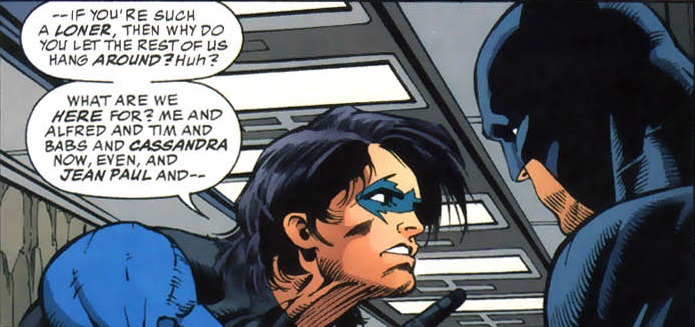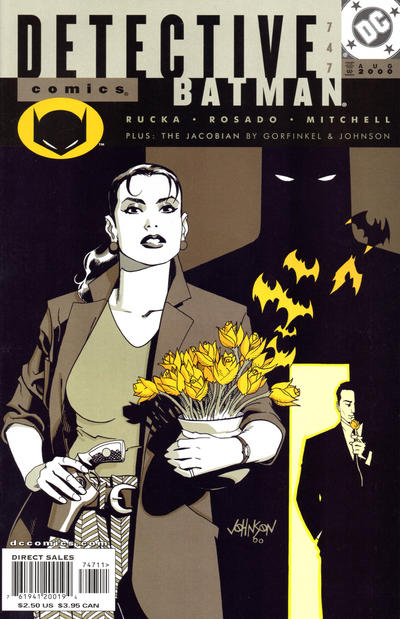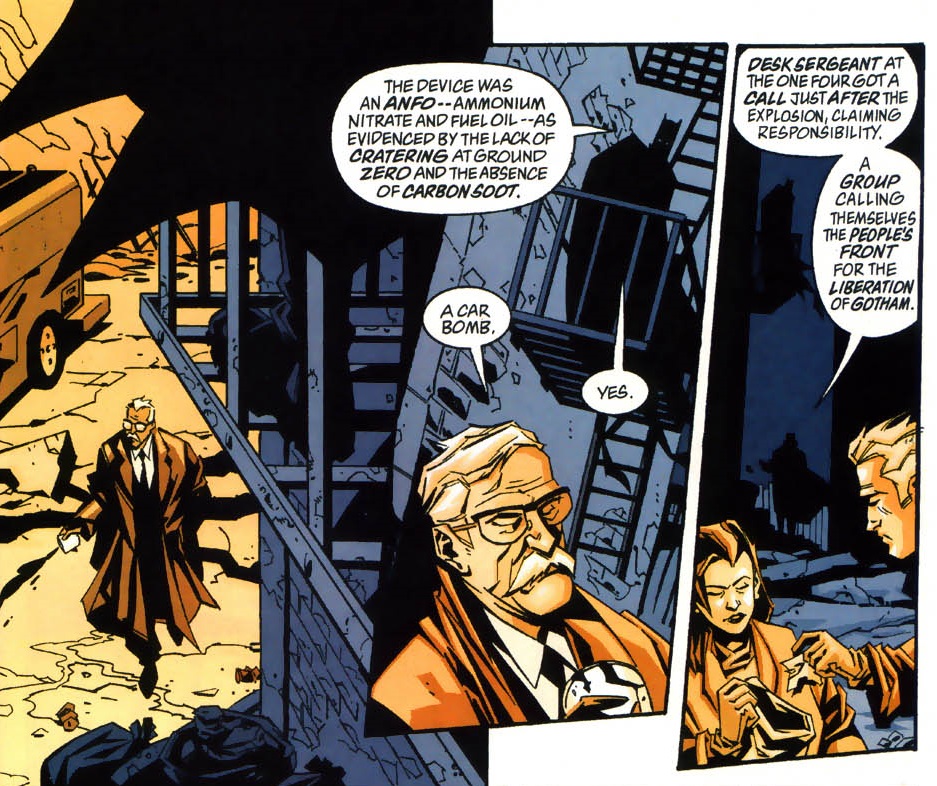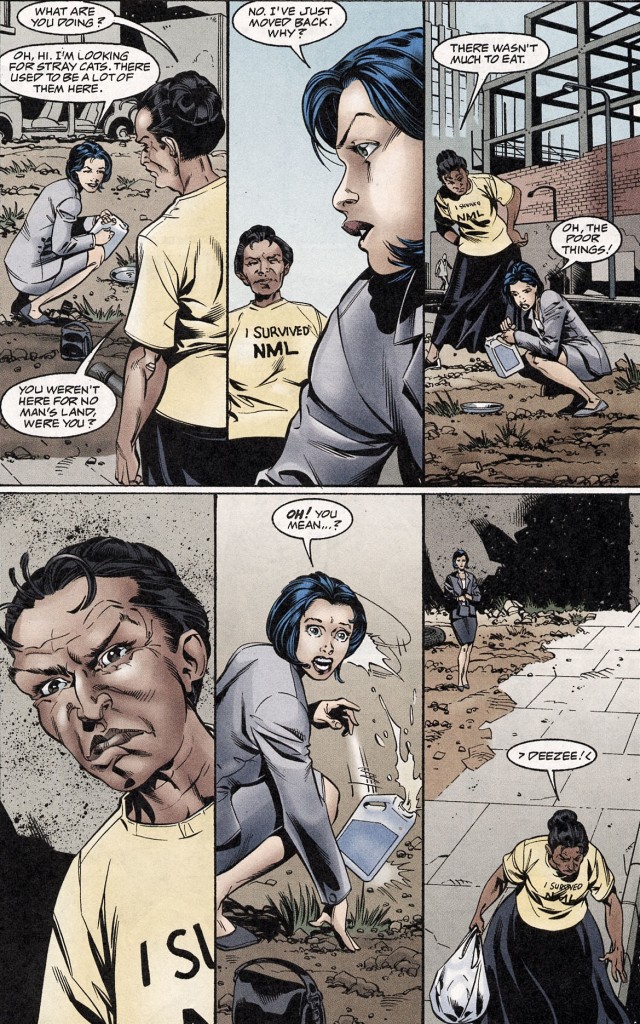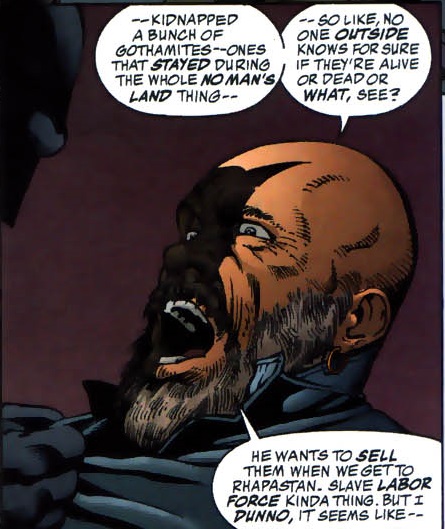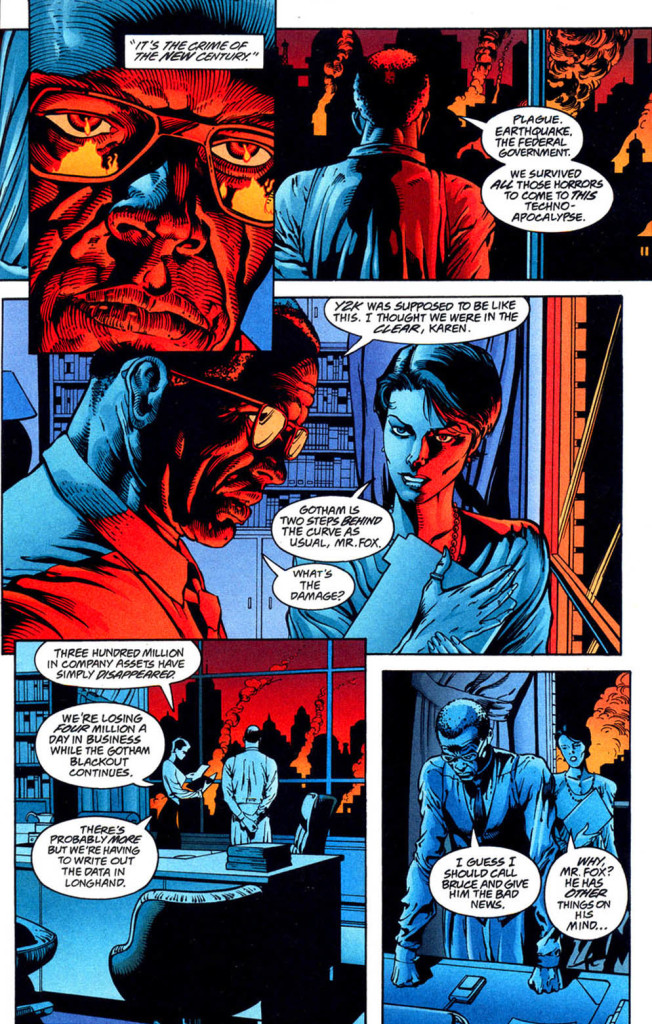A year ago, I did a couple of posts about the coolest stories from the 1999 mega-crossover No Man’s Land, in which Gotham City, partly destroyed by an earthquake, descended into chaos and was cut off from the rest of the United States. That crossover marked an editorial high point in Batman comics, with a strong sense of geographical consistency and narrative unity across the various series, creating an effect that really appeals to me: rather than a mere backdrop to the Caped Crusader’s adventures, Gotham felt like a lived-in city where several simultaneous sagas were taking place and affecting each other.
This didn’t end with No Man’s Land. In 2000, after that crossover wrapped up, group editor Denny O’Neil gave the new creative teams detailed instructions on how the reconstructed Gotham was to be handled, visually as well as sociologically. During the ensuing ‘New Gotham’ era, we got to see the city gradually return to its version of normality as both recognizable characters and anonymous citizens recovered from the events of the previous year. In other words, O’Neil found a way to make the act of returning to the old status quo seem fresh and engaging.
I’m quite fond of this era, with its subplots about local politics and its forceful sense of purpose. These are some of my favorite stories to come out at the time:
‘Constants’
(Gotham Knights #1)
The ‘New Gotham’ era saw the debut of Gotham Knights, which replaced Shadow of the Bat as the series with a greater focus on Batman’s supporting cast. It kicked off with this excellent tale about the Dark Knight and his network of crimefighters (Robin, Nightwing, Oracle, Huntress, Azrael, Batgirl) investigating the double-homicide of Senator Jack Myles and his wife Eileen. Myles, who had been among the senators that voted to give up on Gotham, had left the city during NML and, upon his recent return, kicked four members of the Xhosa gang out of his house. The investigation therefore introduces readers to the booming rivalry between those who deserted Gotham (‘Deezees’) and those who stayed (‘Original Gothamites,’ or OGs) as well as to the city’s predictably rampant corruption over zoning regulations.
That said, the obvious dramatic tension revolves around everybody’s concern for Batman’s objectivity, since the fact that the murdered couple left an orphaned boy behind hits particularly close to home. The final twist isn’t unique (a later Batman arc followed the same beats), but it’s well-earned through the sharp characterization written by Devin K. Grayson, who makes the question of nostalgia-vs-evolution a central motif in the comic (ultimately a meta-commentary, since Batman comics were themselves undergoing a transformation).
As a bonus, the issue is notable for Warren Ellis’ and Jim Lee’s gritty backup short story ‘To Become the Bat.’
‘Happy Birthday Two You…’
(Detective Comics #747)
Let’s start with Dave Johnson’s cover. Detective Renee Montoya is in the foreground, which makes sense since she is the true star of this issue. She has a gun, but it’s holstered, because this is not an action comic – if anything, it’s about the least thrilling aspects of being in the police force. Montoya is holding the tulips she receives early on in the story (and which play a central role in the narrative). The flowers turn into stylized bats that fly in the direction of Batman’s silhouette, lurking in the background and hovering over the figure divided between light and darkness. The design and colors guide our eyes in a specific movement (from the center to the figure in the top right and then down to the figure in the bottom right) that suggests Montoya’s own path in the story. Yet this also works thematically, conveying the duality motif while highlighting the fact that Batman is watching over the characters (and on top of things).
Inside, the color scheme (by Wildstorm FX) is just as narrow, consisting mostly of variations of orange and blueish purple, with people often appearing in a different tone than the world around them (thus suggesting a sense of alienation). The lack of realism works well with the art of William Rosado and Steve Mitchell, which is more about functional storytelling than needless details. The result is incredibly moody in its simplicity.
All of this helps Greg Rucka get away with what is essentially a melancholic character piece about Renee Montoya having a lousy birthday (among other things, because she helps put an OG in prison for stabbing a Deezee) yet turning it around with a good action. Because Rucka is such a great writer, not only is the whole thing refreshingly restrained and mature, it also calls back to Montoya’s arc in No Man’s Land while subtly planting the seeds for the excellent ‘Half a Life’ storyline in Gotham Central, five years later.
‘Urban Renewal’
(Detective Comics #748-749)
Much of Greg Rucka’s 2000-2002 run in Detective Comics was written as a sophisticated police procedural (it’s ultimately a precursor to Gotham Central, establishing many of its character dynamics). He followed ‘Happy Birthday Two You…’ with this taut two-parter mystery about the bombing of a Wayne Enterprises housing development by a terrorist organization that appears to be a splinter group from the OG movement.
It’s always nice to see Batman doing proper detective work (including a very nifty use of the Batcomputer!), but it’s extra-nice to see his investigation in parallel with the police force’s, each following different clues and methods. Even Commissioner Gordon – still dealing with the loss of his wife, Sarah, during NML – gets involved, revisiting his hardboiled cop roots.
Phil Hester’s pencils are blockier than William Rosado’s, but Steve Mitchell’s inks and, especially, Wildstorm FX’s noirish palette assure the visual continuity. I particularly like the splash page with Bruce Wayne changing from his Batman costume to civilian clothes while carrying on with his investigation at every step – this is the kind of ultra-efficient and determined rendition of the Dark Knight that makes him such a fun character to watch.
‘Plus Ça Change’
(Catwoman (v2) #78)
As the title suggests, ‘Plus Ça Change’ is another comic about the tension between changing and staying the same, with Gotham’s identity once again mirroring the state of the Bat-books. Indeed, the ‘New Gotham’ era marked a whole new direction for Catwoman: after seven years of Jim Balent’s hyper-voluptuous art, Staz Johnson brought in a noticeably less exploitative style (albeit also sensual, in its own way). Meanwhile, writer Bronwyn Carlton, who would eventually take Selina Kyle into some pretty dark places, wisely chose to open her run with the confident, resourceful version of the character we all love.
In this first issue, a recently returned Selina sets her sights on the Crystal Spire, the heavily protected symbol of Gotham City’s rebirth. In order to show the world that she’s back, Catwoman uses her wits and feminine wiles to go through the security system and humiliate the police force (something that will come back to bite her in the ass in later issues). The twist, when it comes, is especially satisfying because it ties into Gotham’s atmosphere of cynicism about its gentrified future, with Carlton populating the comic with a variety of distinctive supporting characters.
‘Down with the Ship’
(Gotham Knights #2)
The second issue of Devin Grayson’s and Dale Eaglesham’s Gotham Knights run is even tighter than the first. ‘Down with the Ship’ starts with a fast-paced montage that culminates in the realization that Batman and Batgirl have to race against time if they hope to save the lives of a bunch of kidnapped Gothamites… It’s one hell of a thriller – although Pamela Rambo’s colors drown some of the elegance out of Eaglesham’s pencils and John Floyd’s inks, the artists manage to convey the dynamism and claustrophobia of the rescue mission, including a key confrontation in a room quickly filling up with water.
Ostensibly, this is a story about the latest Batgirl (Cassandra Cain) and her death wish. Yet Grayson keeps adding layers through the juxtaposed narration, so that keen readers will realize it’s also a story about the Dark Knight dealing with his traumas and trust issues regarding his partners (at a time when the death of Jason Todd was still canon). And yes, in a way ‘Down with the Ship’ is also a story about the fact that Gotham authorities and records are still kind of a mess, to the point that they’re not even sure of who’s alive or dead.
The issue finishes with an entertaining Golden Age pastiche, written and illustrated by John Byrne.
‘All the Deadly Days’
(Batman 80-Page Giant #3)
Speaking of pastiches, ‘All the Deadly Days’ opens with a wonderful flashback of Batman and the original Robin (Dick Grayson) fighting the Calendar Man at an exhibition about time (‘Man and the 4th Dimension’). The sight of the Dynamic Duo kicking the butt of goofy-looking henchmen while trading quips among giant clocks and hourglasses is given the proper Golden Age feel by Joe Staton’s art (which evokes the bulky style of Dick Sprang) and Glenn Whitmore’s bright colors (which become considerably muted in the subsequent section, suiting Manuel Gutierrez’s more realistic pencils). Besides the nostalgic wink, the visual delight, and the set-up for a later pay-off, I love this sequence for the way it suggests that, somehow, this remote era of comics is still part of current continuity (the issue goes on to reference events from Knightfall and Cataclysm), having taken place in an undetermined past, its inconsistencies easily attributed to fuzzy memory.
This loose approach to history may seem like an odd choice for a tale so rooted in a specific period – the main story is explicitly set in the spring and summer of 2000, when a recently released Calendar Man seeks revenge for having just missed the turn of the millennium. However, I love the sequence precisely because it underlines how relative time is, which is the whole point of the issue… the relativity of time and our many attempts to give it some order are what makes the villain’s obsession so silly, what makes his punishment so cruel, and ultimately what makes his crime plot so difficult to decipher. You can also see the randomness of time conventions in the fact that Calendar Man fails to grasp that the technical turn of the millennium would only take place at the end 2000 – since the Gregorian calendar has no year zero – although that’s kind of a moot point, since what he’s trying to recreate is the fear of the apocalypse linked to the Y2K scare (which did indeed take place in the 1999/2000 New Year’s Eve).
Even though ‘All the Deadly Days’ doesn’t address the tension between OGs and Deezees, this comic remains an underrated gem of the ‘New Gotham’ era. The impressive roster of artists includes Mike Deodato, Graham Nolan, Louis Small Jr, Dale Eaglesham, and Bill Sienkiewicz, plus further color work by John Kalisz and Sherilyn Van Valkenburgh. The whole thing is strung together by Chuck Dixon’s typical wit and plotting skills. Dixon knows exactly how to write my platonic ideal of a Batman yarn, one where the Dynamic Duo put together clues to in order to stop a crime spree that comes across as equal parts funny and terrifying.

